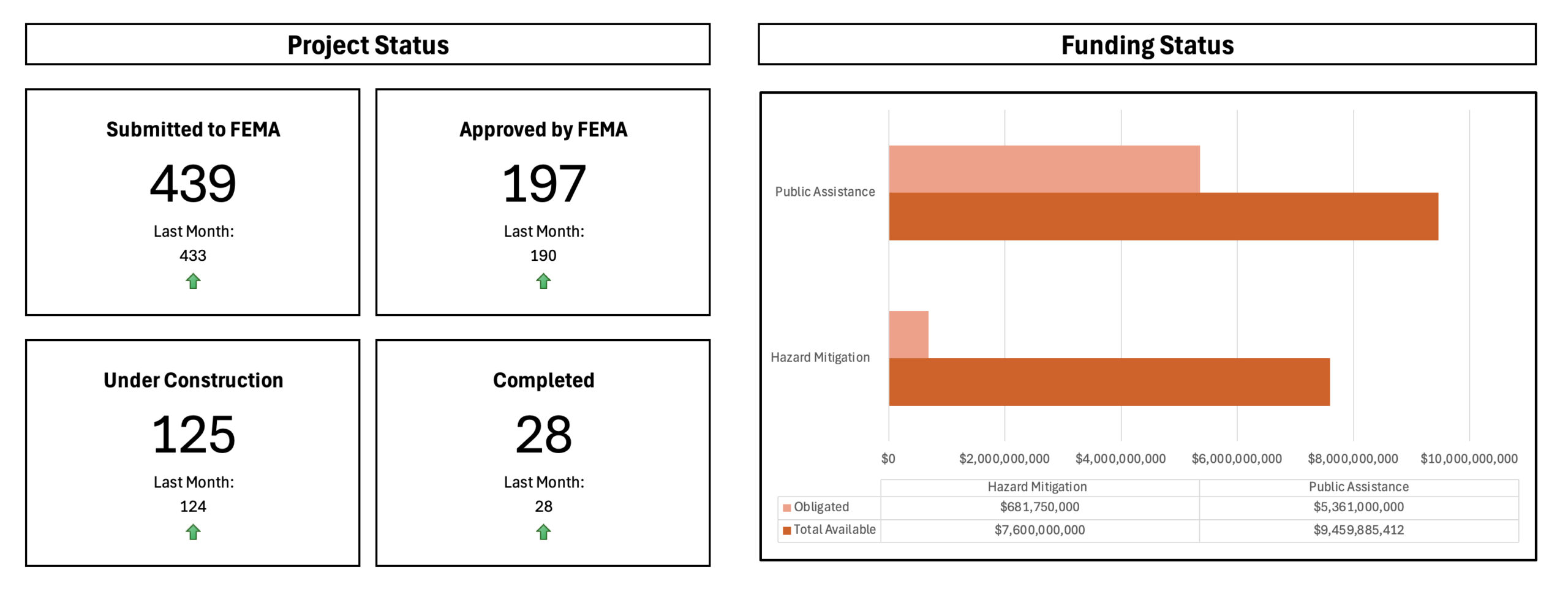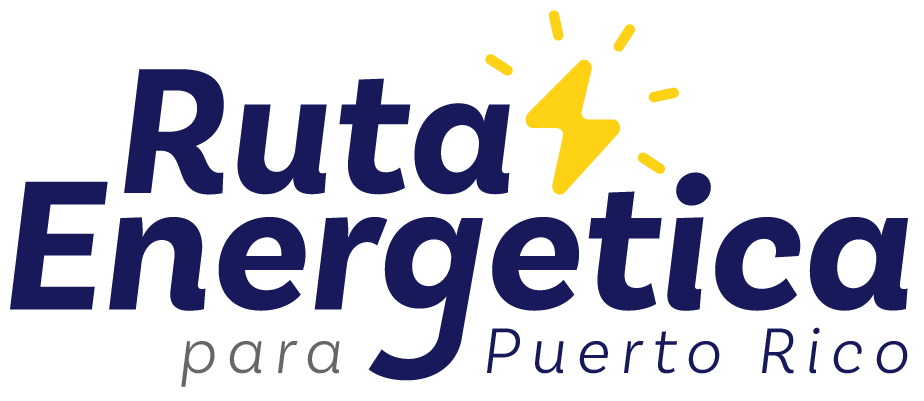Federal Funding
Available and Invested
Federal funding to support energy system recovery and modernization in Puerto Rico has been provided by the Federal Emergency Management Agency (FEMA), U.S. Department of Housing and Urban Development (HUD), and other agencies and departments. This page provides an overview of the largest available sources of federal funding for the energy system.
Federal Emergency Management Agency
In Puerto Rico, FEMA funds are managed by the Central Office for Reconstruction, Recovery and Resiliency (COR3): Public Assistance, Hazard Mitigation Assistance, and Building Resilient Infrastructure and Communities. FEMA also provides funds to support individual assistance as well as additional administration and operations, which are not managed by COR3. More information is available on COR3’s Transparency Portal Recovery Programs page.
Hurricane Maria
The graphic below provides a summary of energy-system recovery projects, including the total number of projects submitted, approved, in construction, and completed, as well as the amount of funding allocated and obligated for these projects.
Hurricane Maria: Status of FEMA Funding for Grid Recovery
Project Status
Submitted to FEMA
439
433
Approved by FEMA
197
190
Under Construction
125
124
Completed
28
28
Funding Status
| Hazard Mitigation | Public Assistance | Total | |
|---|---|---|---|
| Obligated | $681,750,000 | $5,361,000,000 | $6,042,750,000 |
| Total Available | $7,600,000,000 | $9,459,885,412 | $17,059,885,412 |

Other Recent Disasters
The table below shows FEMA funding allocated, obligated, and disbursed by disaster (as of June 2024), based on the scopes of work of projects submitted to FEMA.
| Disaster | Obligated amount ($M) | Disbursed amount ($M) |
| Hurricane Irma | 13,521,955 | 13,495,240 |
| 2020 Earthquake | 370,605,571 | 354,513,703 |
| COVID-19 | 3,786,010 | 2,728,230 |
| Hurricane Fiona | 85,751,103 | 68,981,525 |
Definitions:
- Obligated Funding: A federal authority has signed a contract or made an agreement with a grant recipient. The money is committed but not handed over or spent, yet.
- Disbursed Funding: A federal authority distributes funds to the grant recipient. The money is transferred to the recipient’s account, and the recipient can use it to complete the project or program for which they were funded.
- Total Available Funding – Hurricane Maria Public Assistance: When an area has received a Presidential declaration of an emergency or major disaster, FEMA administers Public Assistance grants to enable permanent repairs of disaster-damaged infrastructure. Given the volume of inspections and the time required to finalize cost estimates for the disaster-damaged assets after Hurricane Maria, PREPA, FEMA, and COR3 agreed to use a statistical sampling methodology to arrive at fixed cost estimate. This approach is known as FEMA Accelerated Awards Strategy and provides a fixed amount of available funding for grid recovery activities.
- Total Available Funding – Hurricane Maria Hazard Mitigation: In addition to Public Assistance funding, FEMA provides discretionary authority to fund mitigation measures in conjunction with the repair of the disaster-damaged facilities. For Hurricane Maria, FEMA arrived at a maximum potential benefit, referred to herein as “total available funding,” based on the FEMA Accelerated Awards Strategy fixed cost estimate and the expected mitigation impacts (e.g., mitigated loss of service) of planned activities.
U.S. Department of Housing and Urban Development
HUD provides flexible grants to help cities, counties, and states recover from disasters, especially in low-income areas. HUD funding to support energy system recovery in Puerto Rico is provided through HUD’s Community Development Block Grant (CDGB) Disaster Recovery (DR) and Mitigation (MIT) programs.
CDBG-DR Energy includes a separate fund for Electrical System Enhancements which supports two primary programs:
- Energy Grid Rehabilitation and Reconstruction Cost Share (ER1) ($500M budget)
- Energy Electrical Power Reliability and Resilience (ER2) ($1.3B budget).
Within the CDBG-MIT program, energy-focused programs include:
- Community Energy and Water Resilience Installations (CEWRI) Program, which covers 100% of the cost (up to $40,000) per household for the installation of renewable energy and water storage systems on single-family homes in selected communities ($50M allocated)
- New Energy Program, which covers 100% of the cost (up to $30,000) for installation of renewable energy systems for residents that own a single-family home in which they reside full time for households under 80% of area median family income ($350M allocated)
- Solar Incentive Program, which covers 30% of the cost (up to $15,000) for the installation of renewable energy systems for residents that own a single-family home in which they reside full time for households that are not low- to moderate-income ($100M allocated)
- Agro-Energy Stability Program, which provides renewable energy solutions for agribusinesses and farmers to withstand energy instability and challenges and secure food and agriculture sector ($75M allocated; minimum award of $50,000, maximum of $250,000).
HUD CDBG-DR and CDBG-MIT funding for Puerto Rico is managed by the Puerto Rico Department of Housing (Vivienda). More information about CDBG-DR and CDBG-MIT funding and programs for Puerto Rico is available on COR’s Transparency Portal Programs page.
U.S. Department of Energy
In February 2023, DOE’s Grid Deployment Office launched the Puerto Rico Energy Resilience Fund (PR-ERF) to support grid resilience efforts and help the Commonwealth meet 100% of its electricity generation with renewable sources by 2050 (per Act 17). The PR-ERF is managed by the Grid Deployment Office in consultation with FEMA and HUD, and is being developed in consultation with local entities and communities to increase energy resilience and reduce the energy burden of vulnerable residents.
In February 2024, DOE launched the Programa Acceso Solar (Solar Access Program) to connect low-income Puerto Rican households with subsidized residential solar and battery storage systems. This initiative is funded through Topic Area 1 of the PR-ERF FOA. Learn more about the Programa Acceso Solar.
In August 2024, DOE announced a $365 million funding opportunity for the new Programa de Comunidades Resilientes to fund solar and battery storage installations for community healthcare facilities and common areas within subsidized multi-family housing properties. In Dececember, DOE announced selected teams with an existing presence in Puerto Rico to enter award negotiations. Learn more about the Programa de Comunidades Resilientes.
Other Federal Programs
Additional sources of federal funding for energy system recovery and modernization include the U.S. Environmental Protection Agency’s (EPA’s) Solar for All program which is part of the Greenhouse Gas Reduction Fund; and the U.S. Department of Agriculture’s Rural Energy for America Program (REAP) and Powering Affordable Clean Energy (PACE) program, which are part of the Inflation Reduction Act.
Resources
Learn about these funding sources and status by visiting the following websites and specific pages.
- COR3 Transparency Portal website including financial analysis of federal disaster grant assistance webpage (includes infographic of recovery funds, table view of funding sources, interactive map, and data visualization)
- Puerto Rico Department of Housing CDBG-DR/MIT Programs page (includes Electrical Systems Enhancements programs)
- FEMA Disasters and Other Declarations

